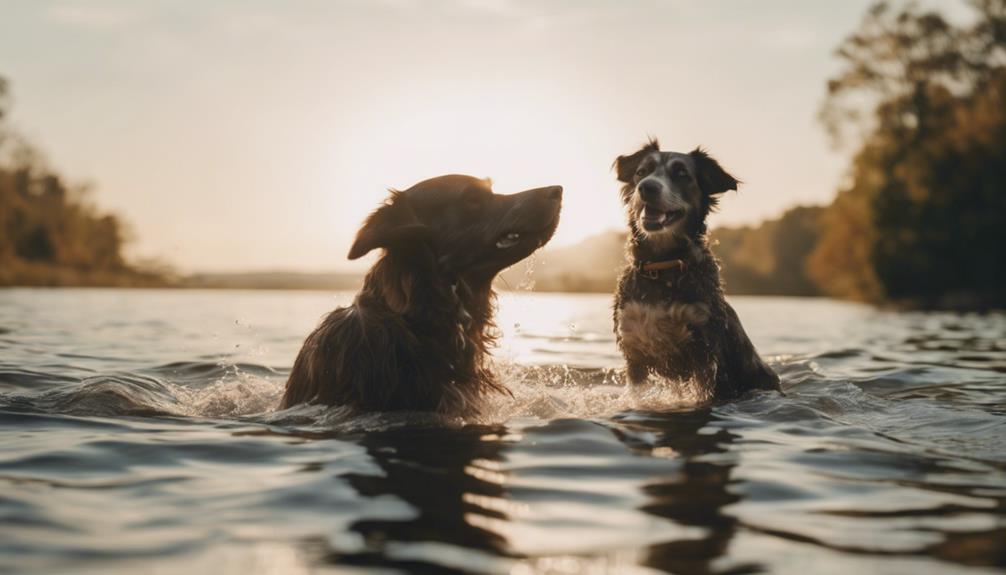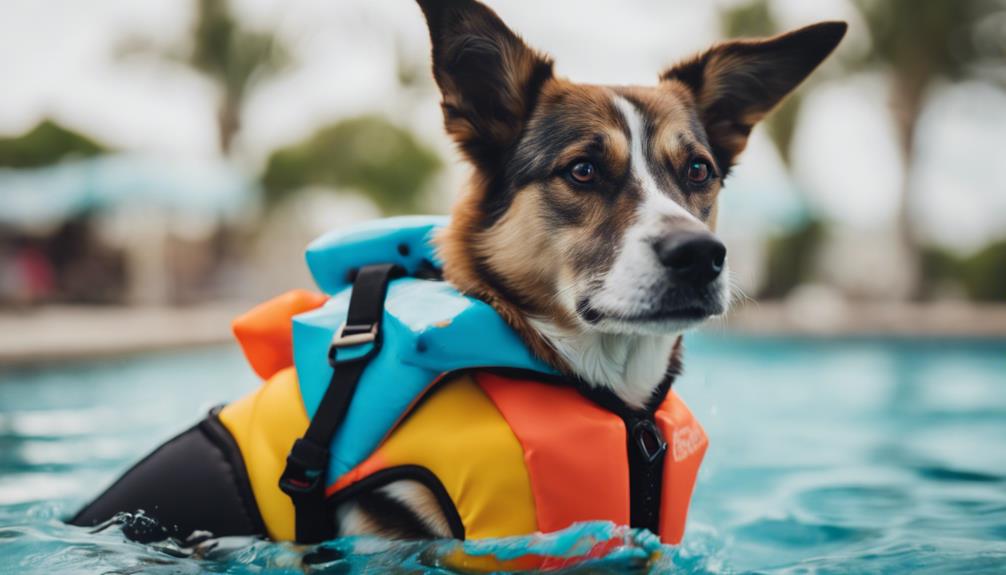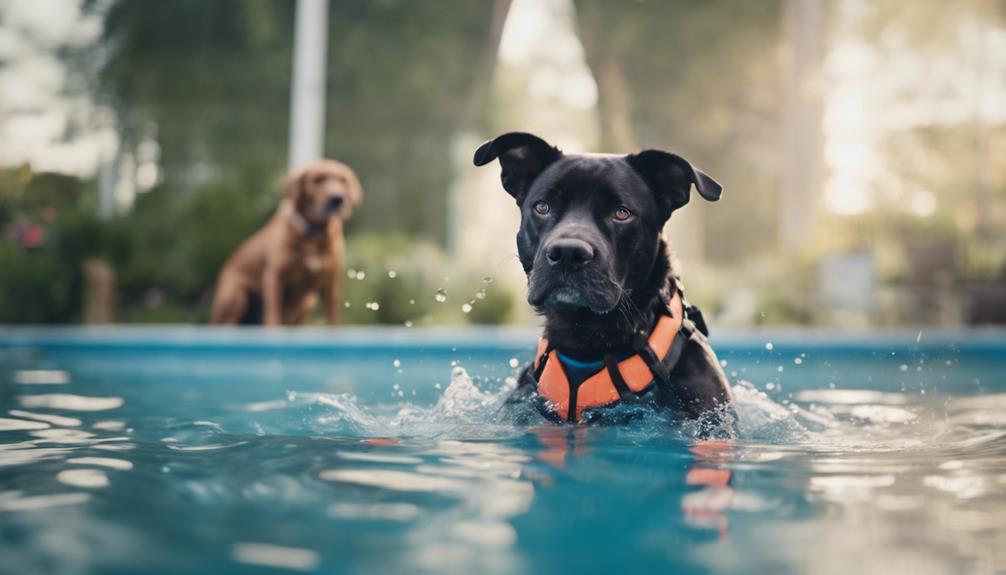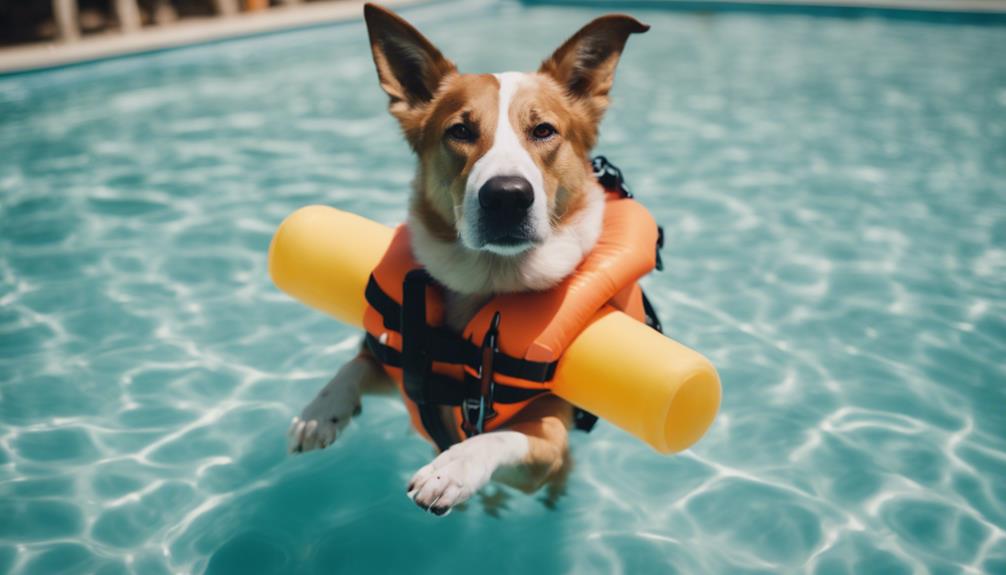Embarking on the journey of teaching your dog to swim can be a rewarding experience, fostering their physical and mental well-being. From understanding the optimal age to commence lessons to unraveling the breed-specific nuances that may influence their aquatic abilities, there are various aspects to consider.
Patience and positive reinforcement stand as pillars in this process, ensuring a harmonious learning curve for your canine companion.
As we delve into the step-by-step guide and safety precautions essential for a secure swimming venture, the discussion expands to encompass a broader spectrum of dog-friendly activities and resources, enriching your understanding of this enriching endeavor.
Key Takeaways
- Start teaching your dog to swim at a young age for physical and mental development.
- Use patience and positive reinforcement to help your dog become comfortable in the water.
- Consider using a life jacket for safety, especially in uncontrolled environments.
- Seek professional guidance for flat-faced breeds to ensure a safe swimming experience.
Starting Age and Benefits
Commencing swimming lessons at an optimal age between 6 months and 2 years not only fosters physical and mental development in dogs but also instills confidence and comfort in water-related experiences. Introducing puppies to swimming during this critical developmental stage helps build their muscles, improves coordination, and enhances their overall cognitive abilities. Moreover, early exposure to swimming can prevent water-related fears or anxieties from developing later in life.
The positive associations formed during these initial experiences can significantly impact a dog's lifelong relationship with water, setting the foundation for enjoyable aquatic activities and potentially life-saving skills. Starting at the recommended age range ensures a smooth and successful introduction to swimming for dogs, emphasizing their well-being and confidence in the water.
Teaching Steps and Duration
When instructing your dog in swimming, it is essential to follow a structured approach that focuses on gradual introduction and positive reinforcement techniques. A well-planned teaching strategy can help your dog feel comfortable and confident in the water. Below is a table outlining the steps involved in teaching your dog to swim and the average duration it may take for them to become comfortable with swimming:
| Teaching Steps | Duration |
|---|---|
| Introduce to pool environment | 1-2 sessions |
| Help gradually get into water | 1-2 sessions |
| Guide to swim with encouragement | 1-2 sessions |
| Practice swimming techniques | 1-2 sessions |
| Positive reinforcement and patience | Throughout the process |
Importance of Patience

Demonstrating unwavering patience is paramount when teaching your dog to swim, ensuring a successful and positive learning experience. Patience allows your dog to progress at their own pace, building trust and confidence in the water. Here are some key reasons why patience is crucial in this process:
- Building Trust: Dogs may initially feel anxious or unsure in the water, requiring time to acclimate.
- Encouraging Confidence: Patiently guiding your dog through each step boosts their confidence in swimming abilities.
- Positive Reinforcement: Rewarding small achievements motivates dogs to continue learning and adapting to the water environment.
Safety Measures and Life Jackets
In the realm of teaching your dog to swim, prioritizing safety measures, such as the use of life jackets, is essential to ensuring a secure and controlled aquatic learning environment. Life jackets play a crucial role in preventing drowning incidents and providing added security, even for dogs considered good swimmers. It is important to recognize signs of distress in dogs and allow breaks as needed during swimming sessions. Additionally, constant supervision around water bodies and keeping pools covered when not in use are vital safety precautions. Here is a table summarizing key safety measures and tips for using life jackets effectively:
| Safety Measures | Life Jackets |
|---|---|
| Preventing drowning | Providing added security |
| Recognizing distress | Allowing breaks when needed |
| Constant supervision | Keeping pools covered |
Life Jacket Importance

Emphasizing the significance of life jackets in water activities for dogs is paramount to ensuring their safety and well-being. Life jackets play a crucial role in providing an extra layer of protection, especially in unpredictable water conditions.
Here are key points to consider:
- Life jackets are essential for all dogs, regardless of their swimming abilities.
- They serve as a preventive measure against potential drowning incidents.
- Even proficient swimmers can benefit from the added safety and buoyancy that a life jacket provides.
Recognizing Distress Signs
Recognizing distress signs in dogs during swimming activities is crucial for ensuring their safety and well-being in water environments. It is essential for dog owners to be vigilant and responsive to any signs of distress their canine companions may exhibit while swimming. Here is a table outlining common distress signs in dogs during swimming:
| Distress Signs | Description | Action Needed |
|---|---|---|
| Excessive Panting | Rapid and labored breathing | Move to a shaded area and offer water |
| Limping | Difficulty moving limbs | Check for injuries and seek veterinary help if needed |
| Whining or Yelping | Vocal signs of discomfort | Comfort the dog and assess the situation |
| Trembling | Shaking or quivering | Wrap in a towel and provide warmth |
| Head Held High | Keeping head above water level | Check for fatigue and allow rest time |
Swimming Ability Across Breeds

Different dog breeds exhibit varying levels of swimming ability, influenced by their inherent traits and physical characteristics. While most breeds can learn to swim with proper guidance, some show more natural aptitude than others.
- Breeds like poodles and retrievers often excel at swimming due to their water-loving nature.
- Flat-faced breeds such as bulldogs and pugs may struggle in the water due to their facial structure affecting their breathing and buoyancy.
- It is recommended to seek professional guidance when teaching flat-faced breeds to swim, ensuring their safety and comfort in the water.
Dog-Friendly Activities
Exploring various dog-friendly activities can enrich your bond with your canine companion and provide opportunities for shared adventures. Beyond swimming, engaging in activities like kayaking with your dog can be an exciting experience.
Additionally, there are fun winter activities tailored for dogs that can keep both you and your furry friend active during the colder months. Researching top dog-friendly vacation destinations and beaches can help you plan memorable trips that cater to your dog's needs.
It's crucial to prioritize your dog's health and safety during these activities by ensuring they stay hydrated, protected from extreme weather conditions, and have access to necessary amenities. Articles on canine health, safety, and training tips can further enhance your understanding and enjoyment of these activities.
Additional Information and Resources

For those seeking further guidance and knowledge on various aspects of dog care and activities, a plethora of resources are available to assist in enhancing the well-being and enjoyment of your furry companion.
- Online Articles: Explore a wide range of topics, including different dog breeds, vacation destinations, seasonal activities, crate training tips, bathing techniques, and solutions for common issues like a puppy not eating.
- Training Guides: Access expert advice on ensuring your dog's well-being and enjoyment in various settings and activities, from swimming lessons to other dog-friendly adventures.
- Canine Health Resources: Learn about maintaining your dog's health and safety, with articles covering topics such as nutrition, exercise, and training tips for a happy and healthy pup.
Conclusion
In conclusion, teaching your dog to swim at the appropriate age can offer numerous physical and mental benefits. By following the recommended steps with patience and utilizing safety measures such as life jackets, you can ensure a secure and enjoyable swimming experience for your furry companion.
Understanding the varying swimming abilities across different dog breeds and exploring dog-friendly activities can further enhance your dog's aquatic journey. Additional resources are available to support you in this endeavor.




